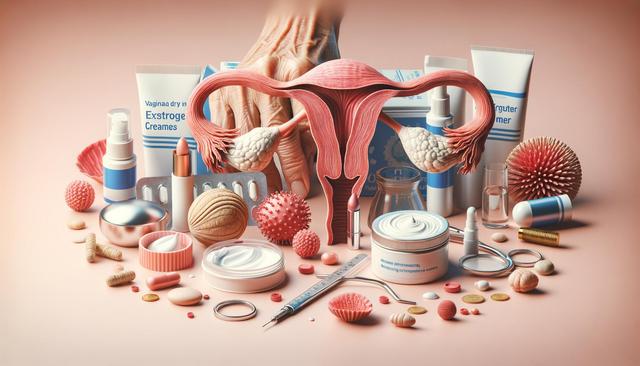Understanding Vaginal Dryness in Postmenopausal Women
Vaginal dryness is a common concern among women after menopause, largely due to the natural decline in estrogen levels. Estrogen plays a vital role in maintaining the thickness, elasticity, and lubrication of vaginal tissues. When estrogen drops, these tissues may become thinner, less elastic, and more prone to dryness and irritation. This can lead to discomfort during daily activities, pain during intercourse, and even an increased risk of urinary tract infections. Recognizing the symptoms early and seeking appropriate care is essential in managing this condition effectively.
Many women may feel hesitant to discuss intimate symptoms, but open communication with healthcare providers can lead to effective treatment options. Among these options, the use of estrogen cream for postmenopausal women is a well-regarded approach. These creams help restore estrogen levels locally within the vaginal area, improving moisture and comfort. It’s important to note that not all symptoms require systemic hormone therapy; localized solutions are often sufficient and come with fewer risks.
What Are Estrogen Creams and How Do They Work?
Estrogen creams are topical applications designed to deliver estrogen directly to the skin or vaginal tissues. When applied as directed, they help replenish the hormone where it is most needed, without significantly impacting the rest of the body. This makes them a suitable option for women experiencing localized symptoms such as vaginal dryness, itching, or burning.
There are different types of estrogen creams available, including:
- Vaginal estrogen cream over the counter: These are non-prescription options that may offer mild relief for minor symptoms.
- Prescription vaginal oestrogen cream: These contain regulated doses of estrogen and are typically recommended for more persistent or severe symptoms.
- Estrogen skin cream: Though often used for other areas of the body, they may have limited benefit when applied externally for intimate dryness.
Consulting a healthcare provider can help identify which product is most appropriate based on individual needs and health history. Application instructions should be followed carefully to ensure safety and effectiveness.
Choosing the Right Treatment for Vaginal Dryness
There is no one-size-fits-all solution when it comes to the treatment of vaginal dryness. Factors such as medical history, severity of symptoms, and personal preferences all play a role in determining the ideal approach. While some women experience noticeable improvement with over-the-counter options, others may require prescription-strength formulations or additional therapies.
Key considerations when choosing a treatment include:
- How severe the symptoms are and how they impact daily life
- Whether the dryness is accompanied by other symptoms such as itching or discomfort during intercourse
- Individual preferences regarding hormonal or non-hormonal treatments
- Any existing health conditions that may influence treatment choices
Some women may also explore complementary approaches, such as pelvic floor exercises, lubricants, or vaginal moisturizers. While these do not replace estrogen, they can provide additional comfort and support tissue health.
The Role of Estrogen Creams Beyond Vaginal Health
While vaginal estrogen creams are primarily used for intimate health, some women explore the use of estrogen cream for face and other areas affected by aging and hormonal changes. These creams aim to improve skin elasticity, reduce dryness, and promote a more youthful appearance. However, it’s important to use these products under medical supervision, as systemic absorption can occur depending on the formulation and frequency of use.
In contrast, estrogen cream for postmenopausal women used vaginally is typically formulated to minimize systemic absorption, which makes it a focused treatment option for intimate symptoms. The distinction is important, as the benefits and risks can vary based on where and how the cream is applied. Always read labels carefully and seek medical advice when considering estrogen-based products for non-vaginal purposes.
While estrogen cream for face may offer cosmetic benefits, it is not intended to replace treatments for vaginal dryness or atrophic vaginitis. Each product has its own purpose, and using the right one for the right condition ensures optimal outcomes and safety.
Practical Tips for Safe and Effective Use
Using estrogen creams correctly is essential to maximize benefits and minimize side effects. Whether using vaginal oestrogen cream or an estrogen skin cream, following the prescribed instructions is a key part of successful treatment. Here are a few practical tips for women starting treatment:
- Apply the cream at the time of day recommended by your provider, usually at bedtime.
- Use the applicator provided to ensure accurate dosing and placement.
- Keep track of symptoms to monitor improvements and discuss any changes with your healthcare provider.
- Report any unusual side effects, such as irritation or spotting, to your doctor promptly.
Building a routine around application can help ensure consistency and better results. It’s also important to continue regular gynecological checkups to assess the ongoing need for treatment and monitor any changes in health status. For women who prefer non-hormonal alternatives, discussing these with a provider can help tailor a treatment plan that aligns with personal comfort and medical guidance.
Conclusion: Empowering Senior Women Through Knowledge and Care
Understanding and addressing intimate health concerns such as vaginal dryness is an important part of aging with confidence and comfort. Estrogen cream for postmenopausal women offers a viable and effective solution for many, especially when used appropriately and under medical guidance. Whether considering a vaginal estrogen cream over the counter or a prescribed option, making informed decisions can greatly enhance quality of life.
By staying informed and proactive, senior women can take charge of their well-being. Open conversations with healthcare providers, thoughtful product choices, and consistent self-care all contribute to healthier, more comfortable aging. Intimate health is not a topic to shy away from—it’s a meaningful part of overall wellness that deserves attention and respect.




Leave a Reply